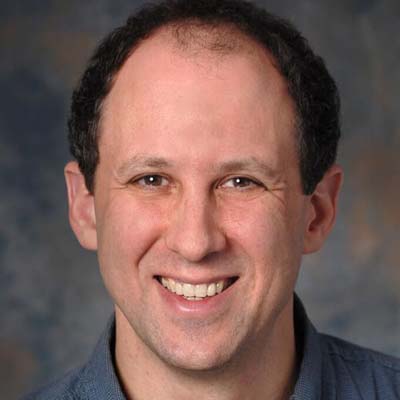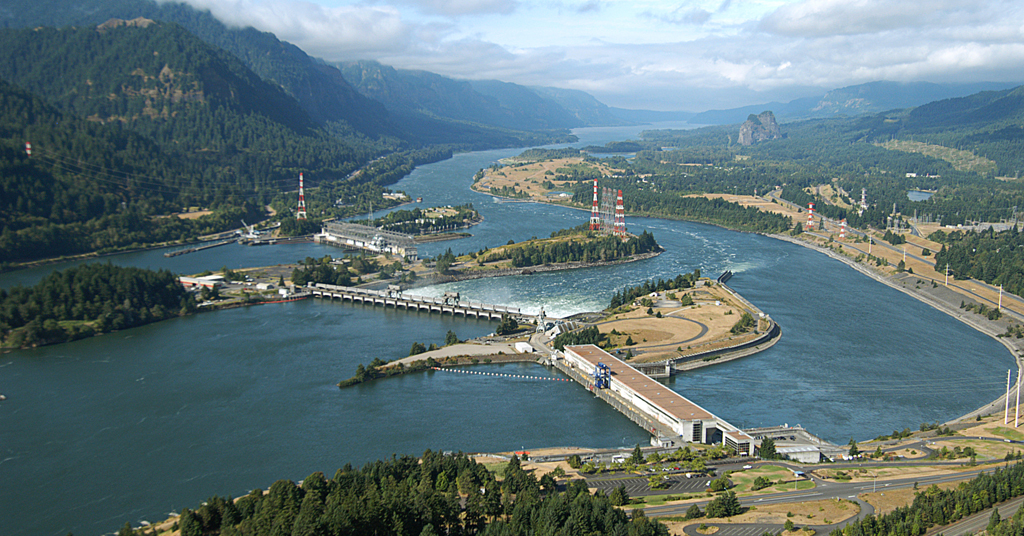A new book, Unbottled, examines the rise of the bottled water industry, and campaigns to protect groundwater in the Columbia River Basin

Getting organized: In 2016, community groups successfully fought to keep a proposed Nestlé water bottling facility out of Cascade Locks, Ore. Photo: Blue Ackerman
Following is an abridged excerpt from Unbottled: The Fight Against Plastic Water and for Water Justice, by Daniel Jaffee, published by the University of California Press. Unbottled examines the movements that have emerged to question the need for bottled water and challenge its growth in North America and worldwide. The book is available from the University of California Press, Amazon and other booksellers.
By Daniel Jaffee. January 4, 2024. In 2008, Nestlé Waters announced a proposal to build a large bottling plant in Cascade Locks, Oregon, a town of 1,100 people in the Columbia River Gorge. The plan would have given Nestlé a fifty-year guarantee of access to 118 million gallons of water annually from state-owned Oxbow Spring, which it would transform into hundreds of millions of bottles of Arrowhead brand water to be sold across the Northwest.
Cascade Locks city officials, two Oregon governors, and the state fish and wildlife agency all lined up behind the proposal, continuing to back it throughout the long approval process.
Yet nearly a decade later, in October 2017, the plan was officially dead.
How was a group of residents and activists able to hold off the world’s largest food and beverage corporation for so long, and eventually scuttle its water bottling plans entirely?
This winding story involves an array of regional and national organizations, a prolonged campaign directed at state government, and the emergence of a homespun local movement that assembled a diverse coalition including Indigenous activists and tribal governments, culminating in a precedent-setting countywide public vote on water bottling that contributed to the proposal’s eventual demise.
However, the broader tale both predates and follows Cascade Locks, incorporating several more Northwest communities where Nestlé and other global bottled water firms have attempted to gain a toehold and access spring water.
Cascade Locks, Goldendale … and beyond
Even before Measure 14-55, which banned water bottling in Hood River County, passed resoundingly at the ballot box in May 2016, Nestlé had begun looking at other communities in the Columbia Gorge as possible spring water bottling sites. It did so under the radar, beginning with the town of Waitsburg, Washington.
According to the Walla Walla Union Bulletin, “[Waitsburg City] Council members … expressed their shock and disappointment that [Mayor Walt] Gobel and City Administrator Randy Hinchliffe had already met with a Nestlé representative several times since February [2016] without their knowledge.”
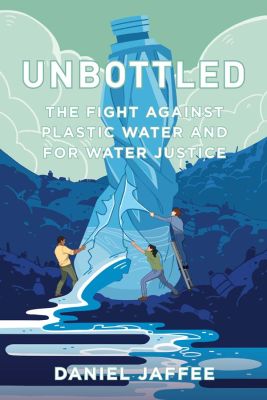
Ultimately, says Julia DeGraw, former Northwest organizer with Food and Water Watch, “Not only did Nestlé get disinvited from bottling water in Waitsburg, but … the mayor of Waitsburg was forced to resign just for talking to Nestlé in private.”
In November 2016 Nestlé tried again to site a bottling plant, in the larger community of Goldendale, Washington.
By this point, the company’s efforts were being closely followed by the activists and tribal members who had won the ballot measure and were determined to help other communities.
Aurora Del Val, former director of the Local Water Alliance (LWA), which led the campaign to pass Measure 14-55, recalls: “[We organized in] a coordinated effort with the residents of Goldendale, neighboring towns, and tribal members a very successful showing of over 150 people at a packed Goldendale City Council meeting once the news broke that Nestlé was talking to the mayor. … A city council member who came to the meeting predisposed to support talks with Nestlé was so moved and shaken by the ‘No Nestlé’ speakers that his level of support needle moved dramatically.”
Yakama Nation attorney Ethan Jones testified at the meeting that “threats to water are threats of genocide to Yakama culture and way of life. … We will do whatever it takes to stop a Nestlé facility from being built in Goldendale.”
Several residents formed the Goldendale Water Coalition, which filed a public records request to unearth details of city leaders’ negotiations with Nestlé. After they revealed their findings in a newspaper op-ed, alleging that officials had worked with business leaders to stack the deck in favor of the deal, the mayor shelved the plan.
In both towns, says DeGraw, “The city leadership and mayors realized this is way more trouble than it’s worth. … And all of those communities referenced Cascade Locks. … And so, we really did keep Nestlé out of the Gorge.”
A leaky Geyser
It was not only Nestlé that viewed the Pacific Northwest as fertile terrain for water bottling.
Crystal Geyser, owned by a Japanese pharmaceutical corporation, owns several springs in California but was seeking another water source. The company bought groundwater-rich land near Randle, Washington, on the Cowlitz River, and in 2019 approached Lewis County officials for permits to build a major bottling plant on the site.
Area residents rapidly organized to oppose the plan, and the local Cowlitz Tribal Council also voted unanimously against it.
Several organizations and activists that were involved in the Nestlé struggle in Oregon reappeared here.
Whitney Kalama, a member of the Confederated Tribes of Warm Springs who organized Columbia River tribal members to oppose Nestle’s Cascade Locks proposal, also worked to raise awareness about Crystal Geyser among tribes in Washington: “Warm Springs and also the Yakama Nation have fishing rights on the Cowlitz River. … I did a lot of emailing to the Chehalis tribe, Yakama Nation … six or seven [tribes], Puyallup, Nisqually . . . [asking], can you take this to your general council or your tribal council?”
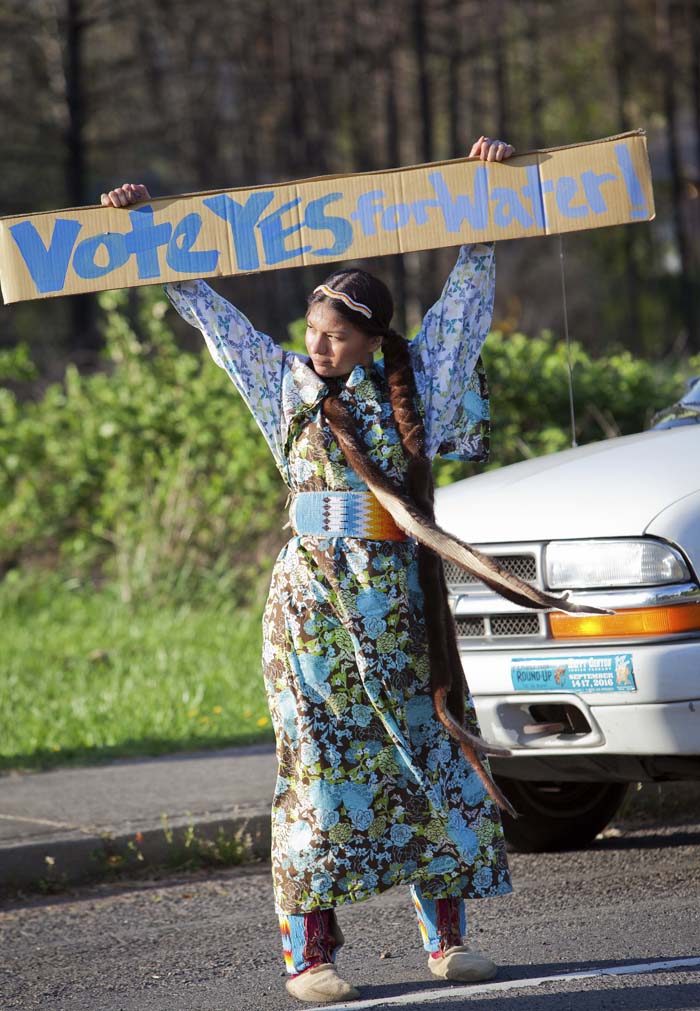
Defending treaty rights: Tribal action was crucial in the effort to prevent privatization of local water sources in the Columbia River Gorge. Photo: Blue Ackerman
Then, because of an astonishing mistake, the company’s strategy for this community was leaked to the media.
Crystal Geyser’s chief operating officer, Page Beykpour, wrote an email to his boss Ronan Papillaud, but inadvertently sent the message to The Chronicle, a local newspaper that was critical of its bottling proposal. The leak outraged opponents and gave their efforts a major boost.
In February 2020, the Lewis County Board of Commissioners approved an ordinance to ban all water bottling in the county—the same result that Hood River County had achieved through the ballot measure.
But bottling opponents now had their sights set higher than a countywide ban.
According to DeGraw, who helped advise the Lewis County effort, “Those organizers in Randle have met with the fricking governor [of Washington]—they’re not messing around. I think they might actually succeed in passing statewide legislation that’s going to make it harder for water bottlers to get permits.”
In fact, an unprecedented bill in the Washington legislature to do just that—ban all permits for bottling spring water (but not municipal water) in the state, retroactive to 2019—passed the state senate in early 2020.
Washington would have become the largest jurisdiction in the world to ban this industry, but the bill died in the state house after fervent opposition from bottled water and beverage industry groups. Its sponsor, Democratic state senator Reuven Carlyle, wrote that “the lethal, mercenary, icy hand of lobbyist bill assassination slaughtered SB 6278 to ban new state permits for commercial bottled water extraction.”
Nonetheless, energized by this near win, bottling opponents say they are considering a statewide ballot measure in Washington to accomplish the same goal.
Lessons from Cascade Locks
As of 2021, thirteen years after it first approached Cascade Locks, Nestlé had still not sited a bottling plant anywhere in the Pacific Northwest. That year, facing falling sales for spring water, Nestlé sold its entire U.S. and Canadian bottled water business to the private equity firm BlueTriton.
After the ballot measure victory in 2016, DeGraw wrote that the outcome “set an important precedent for other communities to follow if they, too, are determined to protect their water.”
But what exactly enabled residents and activists in the Columbia Gorge to hold off the combined efforts of Nestlé, local officials, and state government for a decade, and how transferable are these lessons to other settings?
A handful of factors make the case of Cascade Locks unique, or at least atypical.
First was the crucial detail that Oxbow Spring, the water source Nestlé sought, was state-owned—it was literally public water. This fact combined with Oregon’s water laws to ensure a complex, years-long path to approval, as well as a greater degree of sunshine on the process. It also gave bottling opponents the ability to frame Nestlé’s bottling plans as a private grab of public water, an opportunity they seized to cast the issue as relevant to all Oregonians.
The second factor was the opportunities created by local political structures. The Local Water Alliance and its allies had access to the citizen-initiated local ballot measure, a tool unavailable in many places. This recourse to the ballot, plus the county’s small population and a low signature threshold for qualifying the measure, enabled the LWA to run a local, volunteer-powered campaign at modest cost. The home rule provision in Hood River County allowed a vote to change county law to ban a specific industry, which superseded Cascade Locks’ city government, although the ballot measure was never tested in court.
Finally, the boundaries of the county were favorable to the pro-Measure 14-55 campaign, providing an electorate receptive to their message.

Pure, not so simple: Oxbow Spring in the Columbia River Gorge National Scenic Area. Photo: Blue Ackerman
However, many of the lessons from the battle over water bottling in the Columbia Gorge are more applicable to analogous struggles elsewhere.
The LWA and its allies assembled an extremely broad coalition centered on the defense of local water, harnessing a shared interest in protecting that water in order to transcend political and cultural polarization. They drew on a deep understanding of the community and the particular meanings of water to its multiple constituencies—farmers, orchardists, small businesspeople, recreationalists, tribal members, and fishers, among others.
Rather than focusing on the commodity of bottled water itself, they evoked the potential threat to water availability to galvanize community support.
Reflecting on the outcome, Brent Foster, an attorney who helped draft the ballot measure and was instrumental in the campaign, tells me, “Look, water is the issue that ties everyone together, and so when you’ve got an outside corporate interest like Nestlé threatening the region’s water supply, and just threatening to do something entirely stupid with it, then you couldn’t ask for better glue to pull the community together. I mean, this thing passed by 69 percent of the vote and, despite one of the biggest corporations in the world pouring everything into it, they couldn’t stop it. And I remember some people, even within the environmental community, said, ‘Oh, gosh, how are you ever going to beat Nestlé?’ And I said, ‘How would we not beat Nestlé?’ … Who the hell wants to give away the most precious resource that almost any community has, which is their water supply? For nothing.”
The multiple campaigns against the Nestlé bottling plan—, the LWA, the longer running statewide coalition, and the grassroots work of Native activists—also highlight the importance of understanding and using available political structures, opportunities, and vulnerabilities.
Among those opportunities, the ballot campaign seized on the reality of a Democratic governor [Kate Brown], disinclined to take action to stop the water exchange but sensitive about her environmental image and tribal relationships, facing an upcoming election.
But the governor’s hand needed to be forced, and neither statewide nor local legislation was in the cards. The campaign picked the most favorable strategy and constituency—a county-level ballot measure—for achieving democratic change.
Even more significantly, the LWA and the ballot measure campaign managed to avoid being pulled into the culture war.
“The most important thing is being able to talk about water in a way that is accessible and relates to people from all sides of the political spectrum,” says Foster. “There wasn’t uniform agreement among everyone in the world [on] the fact that, for example, water as a commodity alone was an issue, or the fact that it came in these terrible plastic bottles. … They focused on the core agreement, which was that water—just the presence of it—was so critical locally that we couldn’t watch hundreds of millions of gallons of it get shipped off.”
This highlights the key issues of framing, messaging, and strategy.
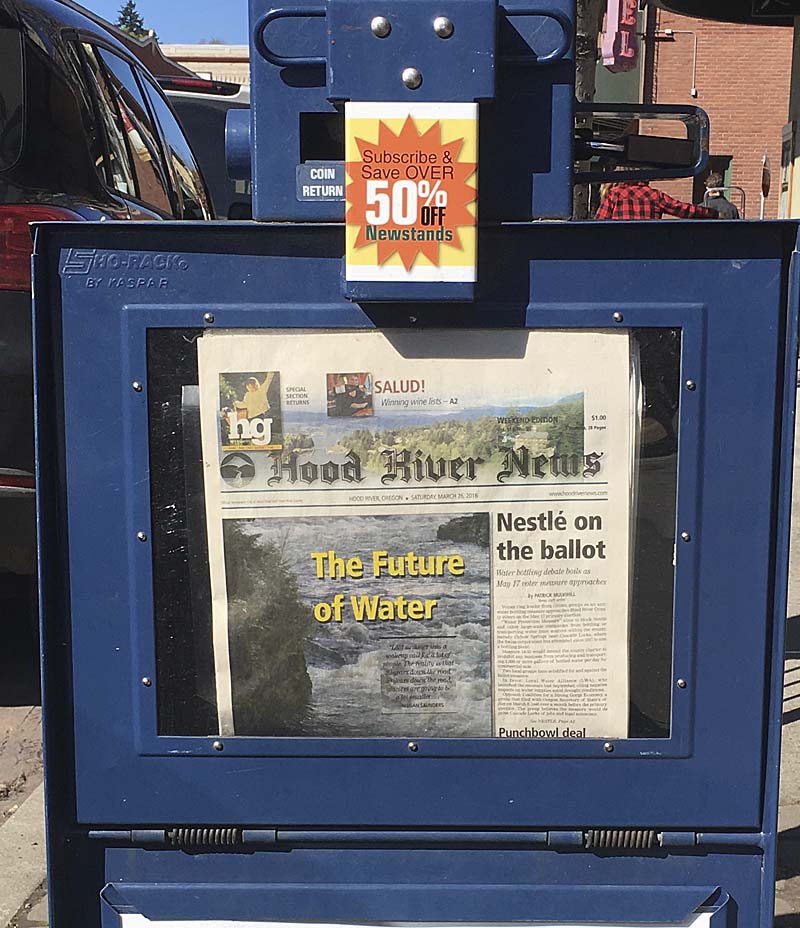
Hot type: As this March 26, 2016, newspaper illustrates, for a while the Nestlé proposal dominated local conversation. Photo: Blue Ackerman
The LWA read the constituency and the moment well in crafting its messages. They were aided by the severe multiyear drought.
Regardless of what individual voters might have believed about climate change, everyone could see the drought—and the specter of present and future water scarcity that it dramatized—which amplified support for the water bottling ban.
In a county whose economic lifeblood is agriculture, with valuable fruit tree crops that cannot be left unwatered or abandoned for a season, the campaign’s choice to frame groundwater extraction for bottling as “exportation” proved savvy.
By juxtaposing removal of water from the region for “unnecessary” bottling against the need to conserve increasingly scarce water for “important” uses—agriculture, local businesses, and homes—the campaign leveraged local norms and values to tap into a rich aquifer of support.
For this messaging to be effective, however, the campaign had to convince voters that Nestlé’s bottling twenty miles west in Cascade Locks posed a threat to their water. The argument that Nestlé would inevitably expand its water extraction to the Hood River Valley, impinging on farmers’ access to water in the not-so-distant future, was central to their campaign.
Finally, in a fairly conservative county with a strong libertarian streak, the campaigners found that opposition to control over local water by a global corporation united voters across the political spectrum.
“At the end of the day,” says Les Perkins, manager of Farmers Irrigation District in Hood River, “I really did feel like it was a rejection of a particular corporation. And that it might’ve been different had it been a local company, doing things a little differently.”
Defending treaty rights and water
The other major element in this struggle was the crucial involvement of Indigenous activists and tribal councils. This played out in two distinct ways.
First, individual tribal members were key protagonists in the anti-Nestlé coalition that emerged in 2015, originally to oppose the water rights exchange and then to support the ballot measure.
The independent activists spoke about the value of this collaboration.
Kalama recalls that in rallying Warm Springs tribal members to travel repeatedly to Cascade Locks to oppose the bottling plan, “I was like … ‘Come on, guys. … We’ve got to be seen. We have to be heard. We have a voice. We have a collective voice, of tribal and nontribal people working together.’ And I can’t say that I remember the last time that something like that happened—bringing nontribal and tribal people together.”
“You’ve got to keep them out because once they’re in, if you try to make them stop their pumping, they’ll sue you into bankruptcy.” —former city councilor Deanna Busdieker
Klairice Westley, a Warm Springs tribal member who lives in Cascade Locks and led two high-profile hunger strikes against the bottling plan, addressed the timing of Native involvement in opposing the Nestlé proposal: “You know, the environmental groups fought for what, eight years, before we even knew about this? So that says a lot. And without them—Food and Water Watch, the Local Water Alliance, and Bark—I don’t know if we would’ve been able to get anywhere as a tribe, once we stepped in, if it wasn’t for them already doing all that work and laying the groundwork.”
She also says the Nestlé struggle marked a break from the historical pattern of relations between Indigenous and non-Native people in the Columbia Gorge: “During the fish wars in the ’80s, everyone was against us. … We were alone. And in the Gorge, with some exceptions in Hood River, the racism and discrimination against Native people is generational and deeply institutionalized. [But] this time, it was different.”
When several Columbia River tribes took formal, public stances on Nestlé’s proposal, exercising their role as sovereign nations and framing the bottling plan as a threat to water, salmon, sovereignty, and (cultural) survival—and thus a violation of treaty rights—this changed the course of events.
Their strong opposition to the fast-track state water rights exchange approval process, partly a result of internal advocacy by Native activists, appears to have been the pivotal factor in derailing that process in 2015.
And the tribes’ credible threats to defend treaty rights in court against the state of Oregon were almost certainly a major factor—possibly the decisive one—in the decision by a governor concerned about her image and political future to finally pull the plug on the proposed water exchange, and thus Nestlé’s bottling plan, in October 2017.

Capital plan: Locals eventually took their fight to Salem. Photo: Blue Ackerman
During this same period, high-profile conflicts erupted elsewhere that underscored the vital role of Indigenous people and their allies as water defenders.
“You should recall that at the same time there was the Standing Rock [protest] going on,” Westley reflects. “And I think at least it let our state government know, Kate Brown … that we’re not going to sit back and be docile. That we’re going to say something. And that you are going to be up against us. That we are a sovereign nation, that we are to be respected. How many treaties have been broken?”
Sharing the playbook
Many participants in this campaign were committed to sharing their experience with other communities facing similar proposals.
“Goldendale was the next place to get hit,” LWA co-founder Pamela Larsen tells me in 2017. “And they [were] emailing us, talking to us, and we [were] giving them information. … Sometimes I’ll get an email from someone, ‘Oh, we’re trying to protect our water, and we want to hear your strategy.’ … So we’re sharing with everyone.”
Among these lessons, participants stressed the urgency of responding immediately if community members learn that their local officials have been approached by a bottling firm.
“You’ve got to keep them out,” warns former Cascade Locks city councilor Deanna Busdieker, “because once they’re in, if you try to make them stop or even slow down their pumping, they’ll sue you into bankruptcy, and continue pumping all the time, because they have a contract.”
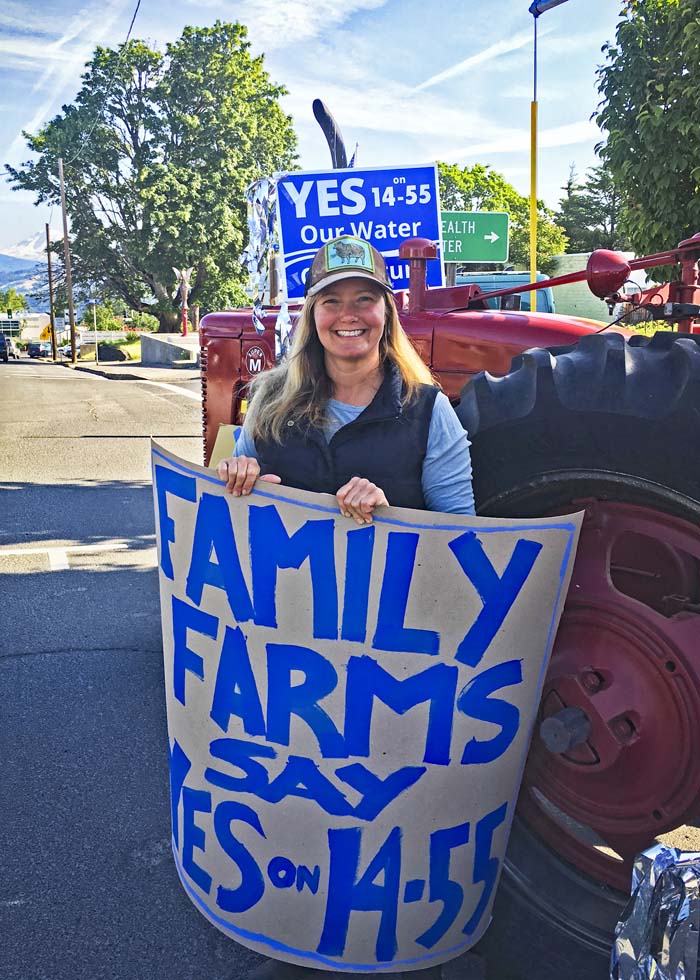
Picking allies: A broad local coalition of interests was needed to derail the plans of a corporate giant. Photo: Blue Ackerman
Del Val stresses that the lessons of the campaign do not pertain only to Nestlé.
“It’s the industry. It’s not one particular company. So that’s why … we have to be really vigilant about protecting our water.” She continues, “I think for communities, what you need to do is talk to each other, and that’s how you can unite. … Instead of being characterized as ‘Oh, you hate our community and you don’t want economic development,’ … we have to look at the risks … to our community and our environment if you let these folks in.”
So many local environmental struggles have outcomes that are indeterminate, or end in outright defeat. A definitive result like the battle over bottling in Cascade Locks raises useful questions about the significance of such a victory.
Foster argues that the grassroots activism that began in the Gorge in 2015 marked a decisive turning point: “This was driven by people in Cascade Locks and kind of spread to Hood River, and people who saw that common theme of water. … Anyone who’s sitting [at] their kitchen table, upset about a proposed bottled water plant, can look at this and say, ‘Aw, geez, these guys are beatable. We can do this.’ And not everybody has the ballot measure power, but even short of a ballot measure, government officials can be recalled. There’s a lot of tools that are out there.”
In late 2019, I speak with Westley one last time, and she recalls the moment when she heard that the governor had finally put an end to the Nestlé bottling proposal.
“I couldn’t believe it,” she says. “My grandchildren were all dancing around the living room with me, and I was so happy that they could see that. And I told them, ‘You can win, but you have to speak up. You have to organize; you have to do something. We can’t sit back and watch this happen.’ My granddaughters were at the rallies, and they saw what it takes.”
Unbottled: The Fight Against Plastic Water and for Water Justice, University of California Press ©Daniel Jaffee



